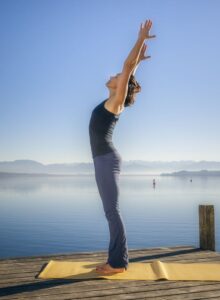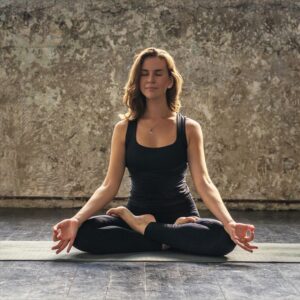YOGA
Yoga is a fantastic practice for beginners as it can help improve flexibility, strength, balance, and overall well-being. Here are some tips to get started as a beginner:
1. Choose the Right Type:
There are many different styles, and it’s important to choose one that suits your preferences and fitness level. Hatha, Vinyasa, and Yin yoga are often good choices for beginners.
2. Start with a Beginner-Friendly Class:
Look for introductory or beginner classes at a local studio, community center, or online. These classes are designed to teach the basics and provide a gentle introduction to the practice.
3. Invest in a Yoga Mat:
A comfortable and non-slip mat will help you maintain stability and provide a cushion for your joints during poses.
4. Wear Comfortable Clothing:
Choose comfortable, breathable clothing that allows for a full range of motion. Yoga is typically practiced barefoot.
5. Learn the Basic Poses:
Begin with foundational poses like Downward Dog, Child’s Pose, Warrior I, and Mountain Pose. These poses are often included in many yoga sequences.

6. Focus on Breath:
Proper breathing is a key component of yoga. Learn to synchronize your breath with your movements. Deep, mindful breathing can help you stay calm and centered.
7. Listen to Your Body:
Pay close attention to how your body feels during each pose. Never force yourself into a position that causes pain or discomfort. Yoga should be a gentle and gradual practice.
8. Warm Up:
Start your practice with a brief warm-up to prepare your muscles and joints. Gentle stretches or a few minutes of deep breathing can help.
9. Practice Regularly:
Consistency is essential for progress in yoga. Try to practice a little bit every day or several times a week to build flexibility and strength.
10. Stay Mindful:
Yoga is not just a physical practice; it’s also about mindfulness and self-awareness. Focus on being present in the moment and connecting with your body and breath.
11. Use Props:
Yoga props like blocks, straps, and bolsters can be helpful for beginners. They provide support and can make poses more accessible.
12. Stay Hydrated:
Drink water before and after your practice to stay hydrated.
13. Seek Guidance:
Consider taking classes from experienced instructors. They can provide personalized guidance, correct your alignment, and offer modifications to suit your level.
14. Be Patient:
Progress may be slow, especially for beginners. Be patient and kind to yourself, and don’t get discouraged by initial difficulties.
15. Practice Savasana:
Each yoga session typically ends with Savasana, a relaxation pose. Spend a few minutes in this pose to relax and calm your body and mind.
10 Yoga Poses For Beginner
Yoga offers a wide range of poses that are suitable for beginners. These poses help improve flexibility, balance, and strength while promoting relaxation and mental clarity. Here are some beginner-friendly poses to get you started:
 1. Mountain Pose (Tadasana):
1. Mountain Pose (Tadasana):
– Stand with your feet together or hip-width apart.
– Keep your arms at your sides, palms facing forward.
– This is a foundational pose for grounding and improving posture.
2. Child’s Pose (Balasana):
– Kneel on the floor with your big toes touching and knees apart.
– Sit back on your heels and stretch your arms forward, lowering your chest to the floor.
– A relaxing pose that stretches the back and helps release tension.
3. Downward-Facing Dog (Adho Mukha Svanasana):
– Start on your hands and knees, with your hands slightly ahead of your shoulders.
– Tuck your toes under and lift your hips to form an inverted V shape.
– It’s a great full-body stretch and strengthening pose.
4. Cobra Pose (Bhujangasana):
– Lie on your stomach with your legs extended.
– Place your hands under your shoulders, and lift your chest while keeping your pelvis on the floor.
– This pose improves back flexibility and strengthens the lower back.
5. Warrior I (Virabhadrasana I):
– Start in a lunge position with your front knee over your ankle.
– Pivot your back foot slightly outward.
– Raise your arms overhead and look forward.
– It builds strength in the legs and opens the chest and shoulders.
6. Triangle Pose (Trikonasana):
– Stand with your feet wide apart.
– Turn your right foot outward and extend your arms parallel to the floor.
– Reach your right hand to your right ankle, shin, or the floor, and extend your left arm upward.
– This pose stretches the legs, side body, and opens the chest.
7. Bridge Pose (Setu Bandha Sarvangasana):
– Lie on your back with your knees bent and feet hip-width apart.
– Lift your hips toward the ceiling while keeping your feet and shoulders on the ground.
– It strengthens the back, glutes, and hamstrings.

8. Seated Forward Bend (Paschimottanasana):
– Sit with your legs extended in front of you.
– Hinge at your hips to reach for your toes or shins.
– Keep your back straight and chest open.
– This pose stretches the hamstrings and spine.
9. Corpse Pose (Savasana):
– Lie flat on your back with your arms and legs extended.
– Close your eyes and focus on deep, relaxing breaths.
– A relaxation pose to conclude your practice.
10. Cat-Cow Pose (Marjaryasana-Bitilasana):
– Start on your hands and knees, with your wrists under your shoulders and knees under your hips.
– Inhale, arch your back (Cow Pose), and look up.
– Exhale, round your back (Cat Pose), and tuck your chin to your chest.
– It’s an excellent way to warm up your spine and improve flexibility.
When starting your practice as a beginner, it’s important to be mindful of certain things to avoid injury and make the experience more enjoyable. Here are some common things to avoid while doing yoga as a beginner:

1.Pushing Yourself Too Hard: Avoid trying to perform advanced poses or pushing yourself too far into a stretch. It’s essential to listen to your body and work within your limits. Overstretching or forcing your body into poses can lead to injury.
2.Comparing Yourself to Others: Yoga is a personal journey, and everyone’s body is different. Avoid comparing your progress to others in the class. Focus on your own growth and well-being.
3.Neglecting Alignment: Proper alignment is crucially to prevent injury and maximize the benefits of each pose. Pay attention to the instructor’s cues or use mirrors to check your alignment.
4.Holding Your Breath: Maintaining a steady and deep breath is an integral part of yoga. Avoid holding your breath while in poses. Breathe naturally and consciously.
5.Skipping Warm-Up and Cool-Down: Always start with a gentle warm-up to prepare your muscles and joints and finish with a cool-down and relaxation. Skipping these can lead to muscle strain and increased soreness.
Yoga’s Potential Pitfalls: Addressing Its Disadvantages
While yoga is generally associated with positive physical and mental health benefits, it’s important to acknowledge that not everyone may have a positive experience. Here are some negative sentiments or concerns that some individuals may have about yoga:
1. Physical Discomfort: Some people may find certain yoga poses uncomfortable or painful, particularly if they have pre-existing physical limitations, injuries, or medical conditions.
2. Frustration with Progress: Yoga progress can be slow, and some individuals may become frustrated if they don’t see immediate results or if they find it challenging to advance to more advanced poses.
3. Competitiveness: In some yoga classes or communities, there can be a competitive atmosphere where individuals feel pressured to perform advanced poses or achieve a certain level of flexibility, which can be counterproductive to the holistic nature of yoga.
4. Cultural Appropriation: Some people criticize the appropriation of yoga from its cultural and spiritual origins, feeling that it has become commercialized and stripped of its traditional meaning.
5. Lack of Access: Not everyone has access to affordable or convenient yoga classes, studios, or experienced instructors, which can be a barrier to practicing it.
6. Misleading Claims: Some individuals may be skeptical of exaggerated claims about yoga’s ability to cure or prevent various health issues.
7. Injury Risk: While yoga is generally considered low-risk for injuries, improper form or pushing beyond one’s limits can lead to injuries. This risk is a concern for some.
8. Expense: Attending yoga classes or buying specialized equipment can be costly, making it less accessible to people with limited financial resources.
9. Time Commitment: A regular practice can be time-consuming, and some people may find it challenging to fit into their busy schedules.
10. Boredom: Some individuals may find yoga routines monotonous, and the repetitive nature of certain poses may lead to a lack of interest or engagement.
It’s important to recognize that yoga is not a one-size-fits-all practice, and different people have different experiences and perspectives. If you have concerns or negative sentiments about yoga, it may be worthwhile to explore various styles of yoga, find a qualified and understanding instructor, or consider alternative forms of exercise and relaxation that better suit your needs and preferences.
BENEFITS OF YOGA
Yoga is a transformative practice that promotes holistic well-being. On a physical level, it enhances flexibility, strength, and balance, leading to improved posture and reduced risk of injury. The deep, mindful breathing involved in yoga reduces stress, promotes relaxation, and calms the mind, helping to alleviate anxiety and depression.
Moreover, it fosters a greater sense of self-awareness, mindfulness, and mental clarity. Regular practice can enhance sleep quality, boost energy levels, and support weight management. By engaging in various poses and meditation, individuals can find relief from chronic pain conditions and improve overall physical health.
The benefits of yoga extend to increased cardiovascular health, lower blood pressure, and a strengthened immune system. Ultimately, yoga is a powerful tool for promoting physical and mental health, nurturing a sense of inner peace, and achieving a harmonious balance in life.
